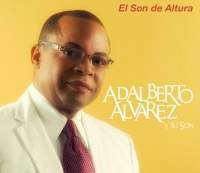12.20.1 Adalberto Álvarez and his Son

Adalberto Álvarez y su Son, a Cuban popular music group founded by its director Adalberto Álvarez, popularly known as El caballero del Son, in the 1980s, specifically in 1984. It is the second group created by this famous Cuban musician, whose debut took place in the municipality of Santiago de las Vegas.
Since its inception, Adalberto has served as a pianist, in addition to his role as director. The orchestra included Jorge Machado, José Martín, José Fernández, Dagoberto Rodríguez, and Ubaldo Canes, among others.
The first phonogram recorded by Adalberto Álvarez y su Son, released in 1985, bears the group’s name as its title. It featured hit songs such as “El Mal de la hipocrisía” (The Evil of Hypocrisy), “Chico quiere que le den candela” (The Evil of Hypocrisy), “Esperando que volver Maria” (Waiting for Maria to Return), and “Mi negra se ha perdida” (My Black Woman Has Gone Crazy).
This year, they performed at the Second Salsa Festival in Spain and toured various cities in Spain, including Madrid, Seville, Gijón, and Tenerife. They shared experiences with international music figures such as Eddie Palmieri and Cheo Feliciano. During this period, they performed at the Winter Carnival at the Hiperia Hotel in Helsinki and at several universities in Finland.
“Para Bailar Casino” was presented in 2003 at the Salón Rosado de La Tropical (41st and 46th Avenue, Playa, Havana). It was recorded under the Bis Music label with the aim of reviving couples dancing.
In 2004, Adalberto Álvarez y su Son embarked on an international tour, performing 15 concerts in countries such as Italy, Germany, the Netherlands, Austria, France, and Switzerland. They later traveled to Canada, where they performed at the Festivalísimo event. At Club Soda in Montreal, they performed a repertoire of the group’s most iconic songs. That summer, they embarked on another international tour in various European countries (Italy, Portugal, Greece, France, Hungary, Spain, and Germany), this time sharing the stage with Changuito and Tata Güines.
In 2005 they recorded the album “Mi linda habanera”, dedicated to Havana.
Since this first production, Adalberto Álvarez’s orchestra has produced one CD per year, totaling 30 albums in 2010. Notable among these are: The Return of Maria, I Dream of a Gypsy, I’m Going With You, Sing It But Dance It, and Weekend, to name a few.
Many of the songs performed by Adalberto Álvarez y su Son have been huge hits both nationally and internationally. Liar Bongosero, My Way, My Reflections, Did You Like Mami, What’s Happening, Love in the Time of Merengue, and Hanging by a Thread. Also worth mentioning are And What You Want to Be Given, Let’s Dance the Toca Toca, What’s Happening Mami, and Dale Como E.
In 2008, the CD Gozando en La Habana, under the Bis Music label, was released to the public in a great concert held at the Karl Marx Theater (Ave. 1ra No. 1010, Miramar, Playa. Havana) located in Havana.
The most recent production by Adalberto Álvarez y su Son began recording in March 2010 at the renowned studios located on 18th Street in Miramar, belonging to the EGREM Recording Company (1008 3rd Street between 10th and 12th Streets, Miramar, Playa, Havana). Initially, the album was going to be titled “Bailing in Tropical Style,” but the Cuban sonero decided to change it to “Son de Altura,” and it was produced under the Bis Music label. The video promoting the group’s new work was directed by Alfredo Ureta. “Bailing in Tropical Style” was the song chosen for the album.
Álvarez and his orchestra have performed at various venues and venues around the world, as well as at prestigious international music festivals. These include the 1987 Salsa Festival; the North Sea Jazz Festival in the Netherlands and Germany; The Hague Festival in the Netherlands; and the 5 de Mayo Festival in San Francisco, USA.








